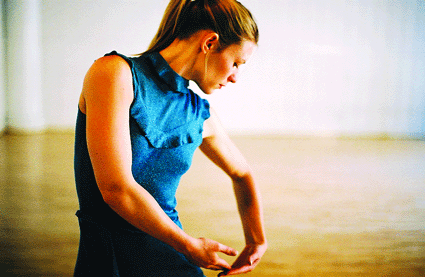Claire Danes’ bold portrayal dances famous Wyeth painting to life
Christina Olson, the model for Andrew Wyeth’s best loved and most widely reproduced painting “Christina’s World,” died in 1968. But Tamar Rogoff has resurrected her.
Real life fashion model and Emmy-award winning actress Claire Danes’ solo captures the beautiful woman idealized in Wyeth’s painting. With Harvey Wang’s video of the Olson house and the meadow that Christina sits in, Rogoff creates the illusion of Christina’s world on the bare P.S. 122 stage. A man in the window plays Wyeth, who was invited by the Olsons to use an upstairs room as a painting studio. His brief appearance is one of the most telling highlights of the dance. His intense stare is almost spooky, and completes the picture of Olson’s character––as seen by Wyeth and the world.
Danes recites several short passages from Richard Meryman’s “Andrew Wyeth––A Secret Life,” and from “Christina Olson – Her World Beyond the Canvas.” For Wyeth, Olson’s beauty and longing gaze represented an American optimism and love of the land. It is not widely known that she had a degenerative disease that caused paralysis of the limbs.
“She was so much bigger than all her little idiosyncrasies,” Meryman writes.
A little over a year ago, when Danes started classes with long-time family friend Rogoff, the choreographer saw the possibilities. Acting is a priority for Rogoff. With Danes’ talent, and long time interest in dance (she debuted at PS 122 at age six), Rogoff’s wheels started spinning.
Danes enters risky territory with her bold portrayal that is almost too real for comfort. Wyeth’s image is safely stationary. Olson did not have to move and with Danes’ legs behind her, immobility and powerlessness were intimated. Rogoff can be commended for utilizing dance’s potential to create a multidimensional image.
Danes pleases with the famous pretty pose, as if looking over the tall grasses at the house. Alternately she runs, walks, jumps, stamps willfully, and rolls on the floor, showing both frustration and a playful, lyrical, if solitary, position. In arabesque, her foot extends flatly. She stands with her feet like slabs turned inward; they are intentionally lifeless, causing us to notice the missing impetus that’s part of the body’s normal anatomy, and a foundation of dance.
Choreographer’s instructions, spoken directly to us in medical lingo, are interesting but problematic. They confuse boundaries among Olson, Danes, Rogoff, and the audience. Olson thinks out loud, “Eloise married Bill Rivers” seeming to trace family lineage; there are photos on the wall outside the theater. It is Danes’ challenge to create authenticity. When her face once stretches into a cat-like shriek, it shows the light is on.
Danes’ long legged rolls across the stage belie the childlike innocence and temper the sugary sentiment of the painting. Changing in and out of her dress she reveals an oddly bright blue slip, and then a black one. In a sort of vision scene on an amplified platform, her contortions are assertive. The mystery and under layers create drama near the end.
A video shows Danes crawling into the P.S. 122 building from First Avenue. The divertissement gives her a rest from her epic live performance, and drives home our empathy with the pitiable condition. Olson refused a wheelchair and instead crawled to a neighbor’s house 800 feet away.
Although Danes is a natural dancer, her performance is not especially driven by the music––a recorded original composition by Christian Frederickson and his band called Rachel’s. Lighting, except for the manèges in the darkness, is especially challenging with the video, and aptly accomplished by David Ferri.
gaycitynews.com


































